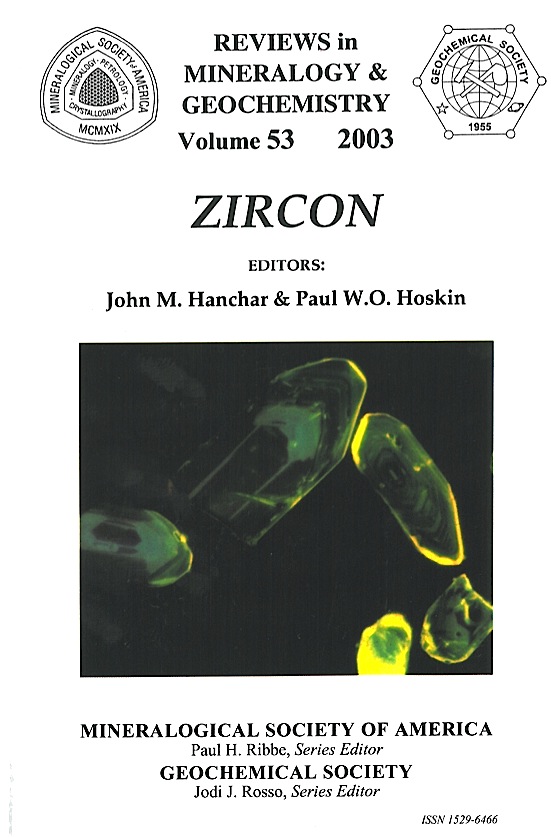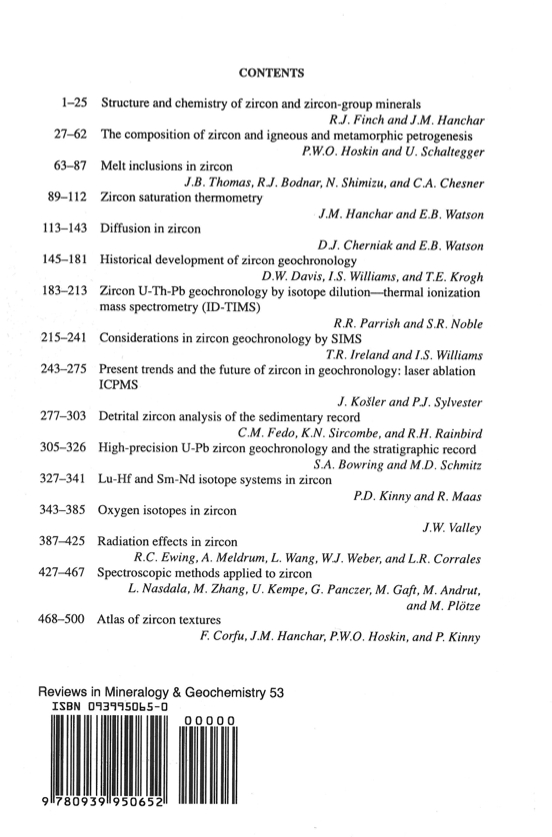

Mineralogical Society of America, Founded December 30, 1919
Order Publications Online (25% discount for MSA, CMS and GS members, except shipping)
MinPubs.org Pay-Per-View GeoScienceWorld Pay-Per-View


2003 i-xviii + 500 pages. ISBN 0-939950-65-0; ISBN13 978-0-939950-65-2
In the two decades since J. Alexander Speer's Zircon chapter in Orthosilicates (Reviews in Mineralogy, Vol. 5), much has been learned about the internal textures, trace-element and isotope geochemistry (both radiogenic and stable) and chemical and mechanical stability of zircon. The application of this knowledge and the use of zircon in geologic studies have become widespread. Today, the study of zircon exists as the pseudo-discipline of "zirconology" that involves materials scientists and geoscientists from across a range of sub-disciplines including stable and radiogenic isotopes, sedimentology, petrology, trace elements and experimental mineralogy. Zirconology has become an important field of research, so much so that coverage of the mineral zircon in a review volume that included zircon as one of many accessory minerals would not meet the needs or interests of the zirconology community in terms of depth or breadth of coverage.
The sixteen chapters in this volume cover the most important aspects of zircon-related research over the past twenty-years and highlight possible future research avenues. Finch and Hanchar (Chapter 1) review the structure of zircon and other mineral (and synthetic) phases with the zircon structure. In most rock types where zircon occurs it is a significant host of the rare-earth elements, Th and U. The abundances of these elements and the form of chondrite-normalized rare-earth element patterns may provide significant information on the processes that generate igneous and metamorphic rocks. The minor and trace element compositions of igneous, metamorphic and hydrothermal zircons are reviewed by Hoskin and Schaltegger in Chapter 2. The investigation of melt inclusions in zircon is an exciting line of new research. Trapped melt inclusions can provide direct information of the trace element and isotopic composition of the melt from which the crystal formed as a function of time throughout the growth of the crystal. Thomas et a!. (Chapter 3) review the study of melt inclusions in zircon. Hanchar and Watson (Chapter 4) review experimental and natural studies of zircon saturation and the use of zircon saturation thermometry for natural rocks. Cation diffusion and oxygen diffusion in zircon is discussed by Cherniak and Watson (Chapter 5). Diffusion studies are essential for providing constraints on the quality of trace element and isotope data and for providing estimates of temperature exposure in geological environments.
Zircon remains the most widely utilized accessory mineral for U- Th-Pb isotope geochronology. Significant instrumental and analytical developments over the past thirty years mean that zircon has an essential role in early Achaean studies, magma genesis, and astrobiology. Four chapters are devoted to different aspects of zircon geochronology. The first of these four, Chapter 6 by Davis et a!., reviews the historical development of zircon geochronology from the mid-1950s to the present; the following three chapters focus on particular techniques for zircon geochronology, namely ID-TIMS (Parrish and Noble, Chapter 7), SIMS (Ireland and Williams, Chapter 8) and ICP-MS (Kosier and Sylvester, Chapter 9). The application of zircon chronology in constraining sediment provenance.and the calibration ofthe geologic time-scale are reviewed by Fedo et al. (Chapter 10) and Bowring and Schmitz (Chapter 11), respectively.
Other isotopic systematics are reviewed for zircon by Kinny and Maas (Chapter 12), who discuss the application of Nd-Sm and Lu-Hf isotopes in zircon to petrogenetic studies, and by Valley (Chapter 13), who discusses the importance of oxygen isotopic studies in traditional and emerging fields of geologic study.
As a host of U and Th, zircon is subject to radiation damage. Radiation damage is likely responsible for isotopic disturbance and promotes mechanical instability. There is increasing interest in both the effect of radiation damage on the zircon crystal structure and mechanisms of damage and recrystallization, as well as the structure of the damaged phase. These studies contribute to an overall understanding of how zircon may behave as a waste-form for safe disposal of radioactive waste and are discussed by Ewing et a!. (Chapter 14). The spectroscopy of zircon, both crystalline and metamict is reviewed by Nadsala et a!. (Chapter 15).
The final chapter, by Corfu et al. (Chapter 16), is an atlas of internal textures of zircon. The imaging of internal textures in zircon is essential for directing the acquisition of geochemical data and to the integrity of conclusions reached once data has been collected and interpreted. This chapter, for the first time, brings into one place textural images that represent common and not so common textures reported in the literature, along with brief interpretations of their significance. There is presently no comparable atlas. It is intended that this chapter will become a reference point for future workers to compare and contrast their own images against.
The chapters in this volume of Reviews in Mineralogy and Geochemistry were prepared for presentation at a Short Course, sponsored by the Mineralogical Society of America (MSA) in Freiburg, Germany, April 3-4, 2003. This preceded a joint meeting of the European Union of Geology, the American Geophysical Union and the European Geophysical Society held in Nice, France, April 6-11, 2003.
John M. Hanchar
Washington, District of Columbia, USA
and
Paul W.O. Hoskin
Freiburg im Breisgau, Germany
September 2003
Title Page
p. i
Copyright
p. ii
Dedication
p. iii - iv
Foreword & Preface
p. v - viii
Table of Contents
p. ix - xviii
Chapter 1. Structure and chemistry of zircon and zircon-group minerals
by Robert J. Finch and John M. Hanchar, p. 1 - 26
Chapter 2. The composition of zircon and igneous and metamorphic petrogenesis
by Paul W. O. Hoskin and Urs Schaltegger, p. 27 - 62
Chapter 3. Melt inclusions in zircon
by J. B. Thomas, Robert J. Bodnar, Nobumichi Shimizu, and Craig A. Chesner, p. 63 - 88
Chapter 4. Zircon saturation thermometry
by John M. Hanchar and E. Bruce Watson, p. 89 - 112
Chapter 5. Diffusion in zircon
by Daniele J. Cherniak and E. Bruce Watson, p. 113 - 144
Chapter 6. Historical development of zircon geochronology
by Donald W. Davis, Ian S. Williams, and Thomas E. Krogh, p. 145 - 182
Chapter 7. Zircon U-Th-Pb geochronology by isotope dilution—thermal ionization mass spectrometry (ID-TIMS)
by Randall R. Parrish and Stephen R. Noble, p. 183 - 214
Chapter 8. Considerations in zircon geochronology by SIMS
by Trevor R. Ireland and Ian S. Williams, p. 215 - 242
Chapter 9. Present trends and the future of zircon in geochronology: laser ablation ICPMS
by Jan Kosler and Paul J. Sylvester, p. 243 - 276
Chapter 10. Detrital zircon analysis of the sedimentary record
by Christopher M. Fedo, Keith N. Sircombe, and Robert H. Rainbird, p. 277 - 304
Chapter 11. High-precision U-Pb zircon geochronology and the stratigraphic record
by Samuel A. Bowring and Mark D. Schmitz, p. 305 - 326
Chapter 12. Lu-Hf and Sm-Nd isotope systems in zircon
by Peter D. Kinny and Roland Maas, p. 327 - 342
Chapter 13. Oxygen isotopes in zircon
by John W. Valley, p. 343 - 386
Chapter 14. Radiation effects in zircon
by Rodney C. Ewing, Alkiviathes Meldrum, LuMin Wang, William J. Weber, and L. René Corrales, p. 387 - 426
Chapter 15. Spectroscopic methods applied to zircon
by Lutz Nasdala, Ming Zhang, Ulf Kempe, Gérard Panczer, Michael Gaft, Michael Andrut, and Michael Plotze, p. 427 - 468
Chapter 16. Atlas of zircon textures
by Fernando Corfu, John M. Hanchar, Paul W.O. Hoskin, and Peter Kinny, p. 469 - 500
Errata for Preface, and Chapters 1, 2, 3, 4, 5, 9, 10, 12, 13, 14, and 15 pdf